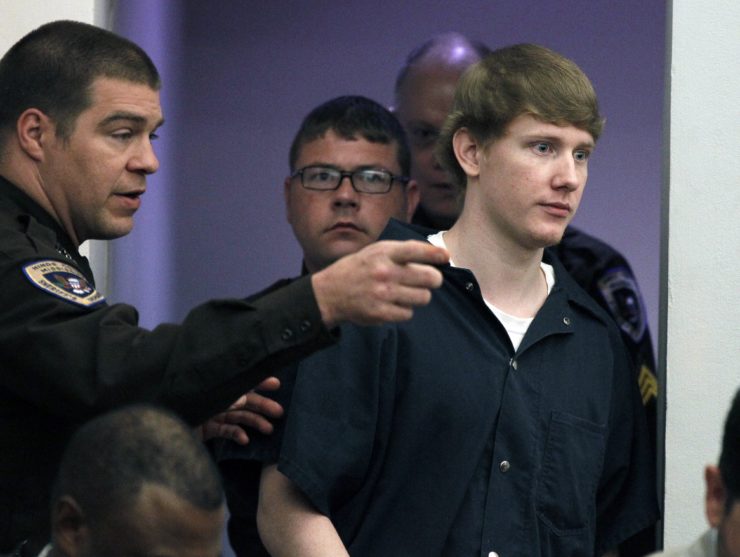Tomorrow’s journalists exploring the masters of today
Jacqui Banaszynski is a Pulitzer Prize-winning journalist who now is an endowed Knight Chair professor at the Missouri School of Journalism. Last semester, her Advanced Writing students at Missouri chose stories they liked and gave them the Storyboard treatment. We’re pleased to post their efforts.
At a time of intense racial tensions in the United States – tensions that visited my own college campus last year – I ran across a story that stopped me in my tracks. In “This Is What They Did for Fun,” BuzzFeed News criminal justice reporter Albert Samaha, covers a modern-day lynching.
Five years ago, James Bradfield’s partner of 18 years, Craig Anderson, was murdered in Jackson, Miss., by white teenagers who ran over Anderson with a truck – apparently because he was black.
Between 1882 and 1968, the story points out, almost 5,000 people, most of them black, were lynched in the U.S.
Samaha’s piece raises a crucial question: Is this startling statistic from our country’s history not left entirely in the past?
His narrative delves into the heart of modern racism and how a family tried to move on from a traumatic loss.
Following is a condensed and edited version of my phone conversation with Samaha.

The concept of your story centers on the racial tension in the U.S. right now. How did you find this particular story to tell?
I remember I heard about the lynching way back when it happened. It left my radar for a few years. I was in Mississippi working on another story, and while I was there, I saw that there was a sentencing hearing for these defendants. I dropped by to check it out, and while I was there, I talked to my editor about it. We decided we should try to see who we could talk to and see if there could be a deeper story that hasn’t been told on this. Let’s see what story there is to tell since the four years that it happened.
I think that what also brought my mind back to it was the judge in the case, Judge Carlton Reeves. He wrote a sentencing statement that was really interesting and long and dove into a lot of the themes I ended up addressing in my story. When the sentencing statement came out, it spread around the criminal justice Twitter community and brought attention back to the case. That’s what initially triggered my eyes back to the story.
I know this is a really sensitive story and a serious topic. How did you end up getting access to the sources you talked to? Did you face any major obstacles while you were trying to do that?
The main source of the story was James Bradfield, the husband of the man who was killed. This is one of those stories that could not have been written without his access. I had been trying for months. I think initially he had said he wasn’t interested, and then he said he was, and then he said he wasn’t. He was really thinking about it and wondering if he wanted to share his story. There was probably a three- to five-month stretch where I wanted to do the story and I had begun gathering information, but he still wasn’t sure if he wanted to speak with me. I started working on other stories and just had that on the backburner. The main obstacle was just trying to speak to him. It was his story, and outside of that, there wasn’t much else. That was the story I wanted to tell. Without Bradfield, I wouldn’t have been able to tell it.
I also spent a lot of time trying to contact all the defendants, the ones who are locked up right now, and their family members. There was a lot of door-knocking. I sent a lot of letters. I did speak to some of the defendants in passing. I tried to get as much as I could in the little time that they were willing to grant me on the phone or over email from a federal prison. That was probably the major obstacle I wasn’t able to totally overcome, getting access to the defendants. I got a little bit from that side. But the story really hinged on James Bradfield.
How were you eventually able to convince James to do the story?
That’s a good question. I don’t know, I don’t know what it was. I think that one thing is that when I initially pitched the story to him, I made it very clear that I understood if he didn’t want to do this. I said: “It’s up to you. You can reach out anytime if you decide you do want to.” So maybe it was making it clear that it was his decision and I didn’t want to pressure him.
Also, I think that one thing that helped was that I was in Mississippi for another story. This was after he said that he didn’t want to do the story. I just told him: “Hey, I’m going to be in Jackson. Would you be free to meet? We can talk off the record and you can get a sense of who I am.” So we met at a restaurant and just talked for three hours. It was partially off the record, and then he agreed to go on the record. I think that that really helped, having a no-pressure situation that gave him a chance to meet with me and feel me out and get my vibe before feeling pressured that this was an official thing that was going down.
I liked the part at the very end of the article where you had dialogue between James and his son (De’Mariouz). How did you build that relationship up to that point where you were able to capture details like that? Were you there or was this something he told you about?

This was something he told me about. I think a lot of the story is rooted on the relationship between James and De’Mariouz. Building that was just kind of developing their relationship, and their relationship with Craig, and their whole family dynamic and the grief that they went through. That was one of those instances where I heard him tell me that anecdote and I thought, “Oh that’s going to be the end of the story.” It worked narratively in the sense that it thematically captures this idea of finding closure without finding closure. I liked that it wasn’t a neat ending. The ending didn’t suggest that suddenly things are better. I did like the way that, no, De’Mariouz hasn’t forgotten about Craig; he is just trying cope for his father. I like what that said about the relationship.
It also made sense chronologically in the sense that it was a recent event. It was the perfect bookend because it happened on the fourth anniversary and it brought us back to the present. It was one of those moments in an interview where you hear a story and think, “Oh, this is perfect for my lede or this is my kicker right here.” That was definitely one of those instances where it just perfectly caught an intersection of all the different aspects I was looking for and how I wanted to end the story.
What did you hope to accomplish from writing this piece?
Primarily, I wanted to write a good, interesting story that lots of people would read. I think that every writer aims to write something that will touch people in one way or another. I think my aim for this story was not different than my aim for every other story that I write. The big idea: the extent to which this form of racism still exists. It was an important idea to convey. We easily forget. We had our first black president and everyone talks about how we live in a post-racial society and I think it’s easy to forget how recent the Civil Rights era was. A lot of the people with the fire hoses and the dogs are still alive today. A lot of those ideas haven’t died over the course of two generations. This old form of racism is still alive today.
Taylor Wanbaugh comes from the great state of North Carolina and graduated from the Missouri School of Journalism in May 2016 with a specialty in magazine journalism. She’s currently working as a consulting writer at an internal PR company in Dallas.



